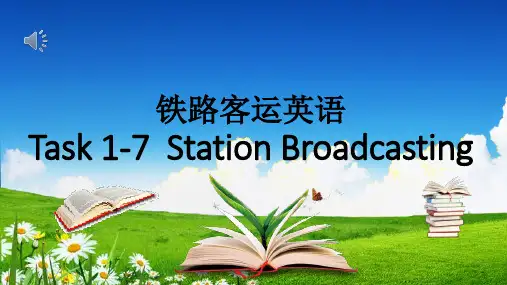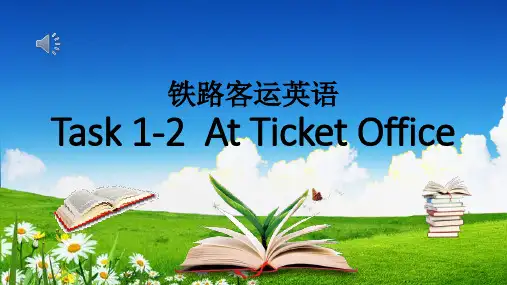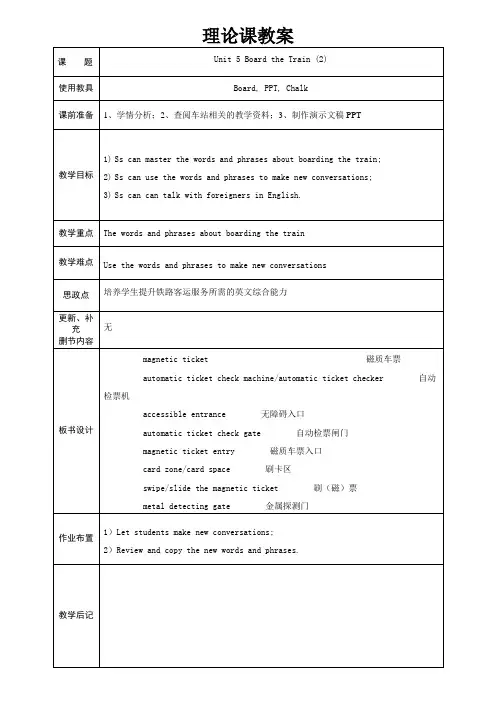铁路客运英语5
- 格式:ppt
- 大小:320.50 KB
- 文档页数:8
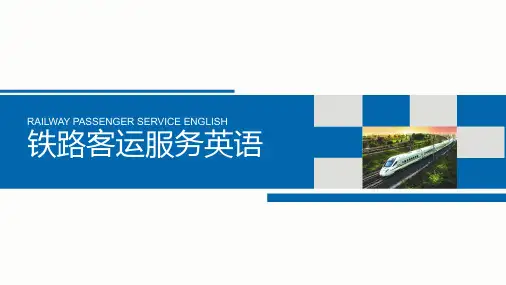
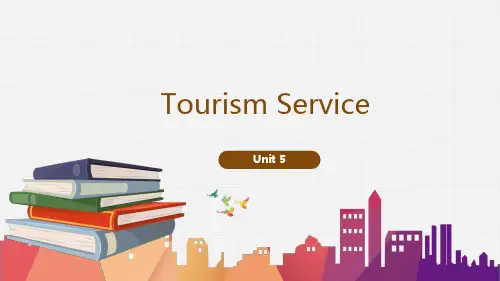
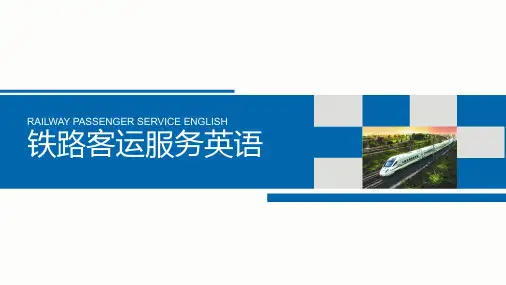
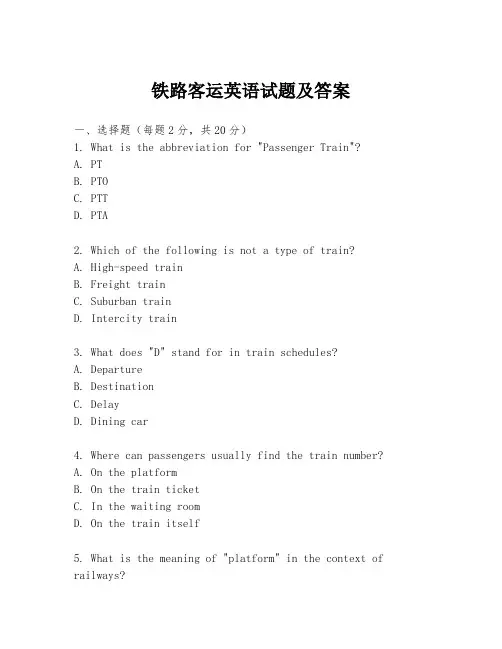
铁路客运英语试题及答案一、选择题(每题2分,共20分)1. What is the abbreviation for "Passenger Train"?A. PTB. PTOC. PTTD. PTA2. Which of the following is not a type of train?A. High-speed trainB. Freight trainC. Suburban trainD. Intercity train3. What does "D" stand for in train schedules?A. DepartureB. DestinationC. DelayD. Dining car4. Where can passengers usually find the train number?A. On the platformB. On the train ticketC. In the waiting roomD. On the train itself5. What is the meaning of "platform" in the context of railways?A. A raised structure for trains to pass overB. A place where trains are loaded or unloadedC. A raised area alongside the tracks where passengers board or alightD. A type of train6. What does "express" refer to in train services?A. A train that travels at high speedsB. A train that makes few or no stopsC. A train that carries mailD. A train that is always on time7. What is the term for a train that operates on a regular schedule?A. Charter trainB. Commuter trainC. Regular trainD. Special train8. Which of the following is not a reason for a train delay?A. Bad weatherB. Technical issuesC. Track maintenanceD. Increased passenger load9. What does "boarding pass" mean?A. A document that allows access to a trainB. A document that shows the train's routeC. A document that lists the train's stopsD. A document that provides information about the train's speed10. What is the term for a train that operates between two specific cities?A. Regional trainB. Intercity trainC. Local trainD. Shuttle train二、填空题(每题2分,共20分)1. The train is scheduled to _______ at 8:00 AM.2. Passengers are advised to arrive at the station at least _______ minutes before departure.3. Smoking is strictly prohibited in all _______ areas of the train.4. The _______ train is known for its comfortable seating and spacious interiors.5. If you need assistance, please contact the _______ desk at the station.6. The _______ train service runs every hour on the hour.7. The train will make a brief stop at the next station for _______ purposes.8. Please ensure your ticket is valid for the _______ you are traveling.9. The train conductor will _______ your tickets during the journey.10. In case of an emergency, pull the _______ cord located next to your seat.三、阅读理解(每题2分,共20分)Read the following passage and answer the questions that follow.Train travel has become an increasingly popular mode of transportation due to its efficiency, comfort, and affordability. Modern trains offer a variety of services to cater to different traveler needs, including dining cars, business class seating, and even sleeper compartments forlong-distance journeys. Trains are also environmentally friendly, emitting less carbon dioxide per passengerkilometer than cars or airplanes.1. What are some of the reasons train travel is popular?2. What types of services do modern trains offer?3. How are trains considered environmentally friendly?四、翻译题(每题5分,共20分)1. 请将下列句子翻译成英文:"所有乘客必须在列车发车前至少10分钟到达站台。
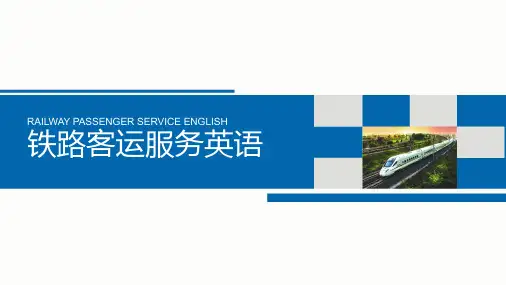
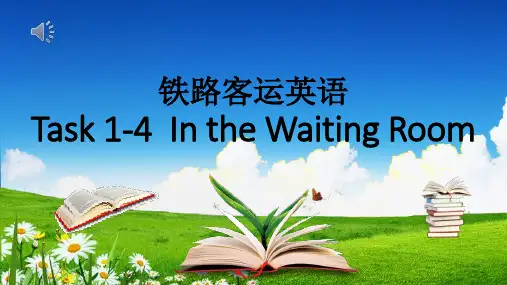
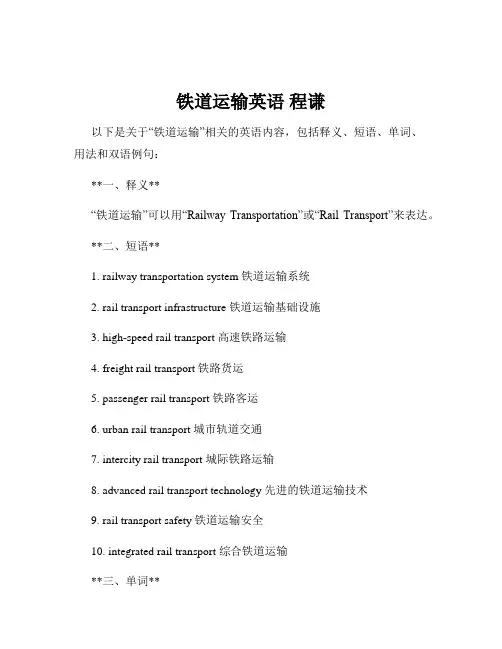
铁道运输英语程谦以下是关于“铁道运输”相关的英语内容,包括释义、短语、单词、用法和双语例句:**一、释义**“铁道运输”可以用“Railway Transportation”或“Rail Transport”来表达。
**二、短语**1. railway transportation system 铁道运输系统2. rail transport infrastructure 铁道运输基础设施3. high-speed rail transport 高速铁路运输4. freight rail transport 铁路货运5. passenger rail transport 铁路客运6. urban rail transport 城市轨道交通7. intercity rail transport 城际铁路运输8. advanced rail transport technology 先进的铁道运输技术9. rail transport safety 铁道运输安全10. integrated rail transport 综合铁道运输**三、单词**1. railway [ˈreɪlweɪ] n. 铁路;铁道- The railway line is under construction. 这条铁路线正在建设中。
2. rail [reɪl] n. 铁轨;横杆;扶手 v. 用栏杆围住;将…围起来- The train runs smoothly on the rails. 火车在铁轨上平稳行驶。
3. transport [ˈtrænspɔːt] n. 运输;交通工具 v. 运输;流放- The goods were transported by truck. 货物是用卡车运输的。
4. locomotive [ˌləʊkəˈməʊtɪv] n. 机车;火车头- The locomotive pulled the long train. 火车头拉着长长的列车。
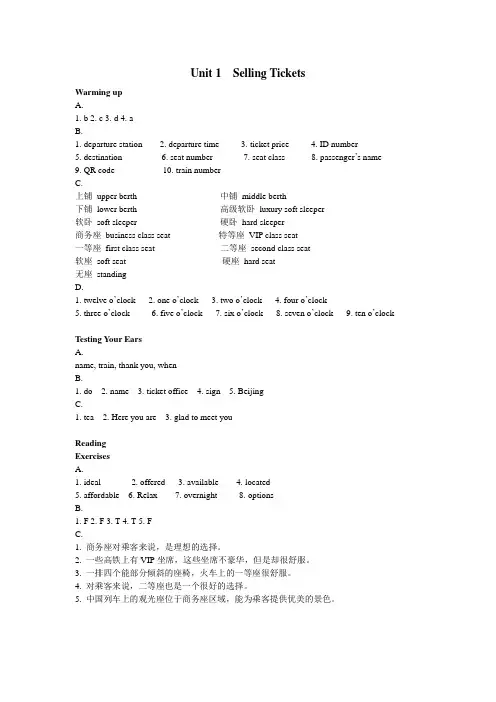
Warming upA.1. b2. c3. d4. aB.1. departure station2. departure time3. ticket price4. ID number5. destination6. seat number7. seat class8. passenger’s name9. QR code 10. train numberC.上铺upper berth 中铺middle berth下铺lower berth 高级软卧luxury soft sleeper软卧soft sleeper 硬卧hard sleeper商务座business class seat 特等座VIP class seat一等座first class seat 二等座second class seat软座soft seat 硬座hard seat无座standingD.1. twelve o’clock2. one o’clock3. two o’clock4. four o’clock5. three o’clock6. five o’clock7. six o’clock8. seven o’clock9. ten o’clockTesting Your EarsA.name, train, thank you, whenB.1. do2. name3. ticket office4. sign5. BeijingC.1. tea2. Here you are3. glad to meet youReadingExercisesA.1. ideal2. offered3. available4. located5. affordable6. Relax7. overnight8. optionsB.1. F2. F3. T4. T5. FC.1. 商务座对乘客来说,是理想的选择。
2. 一些高铁上有VIP坐席,这些坐席不豪华,但是却很舒服。
